TPO 阅读中文翻译
托福TPO1阅读答案与翻译解析3
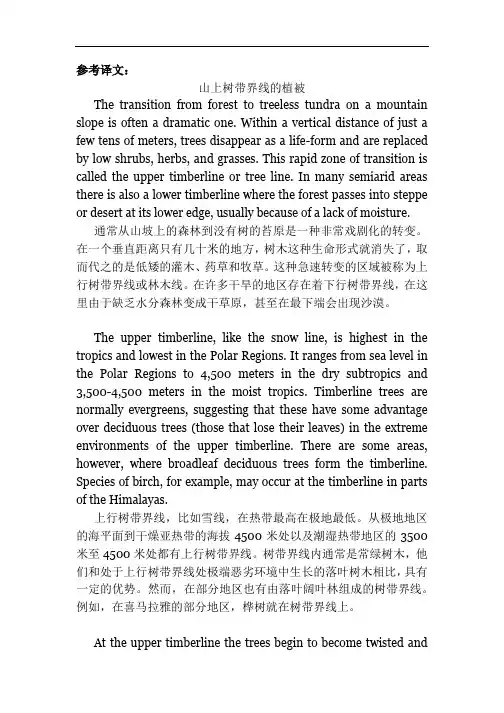
参考译文:山上树带界线的植被The transition from forest to treeless tundra on a mountain slope is often a dramatic one. Within a vertical distance of just a few tens of meters, trees disappear as a life-form and are replaced by low shrubs, herbs, and grasses. This rapid zone of transition is called the upper timberline or tree line. In many semiarid areas there is also a lower timberline where the forest passes into steppe or desert at its lower edge, usually because of a lack of moisture.通常从山坡上的森林到没有树的苔原是一种非常戏剧化的转变。
在一个垂直距离只有几十米的地方,树木这种生命形式就消失了,取而代之的是低矮的灌木、药草和牧草。
这种急速转变的区域被称为上行树带界线或林木线。
在许多干旱的地区存在着下行树带界线,在这里由于缺乏水分森林变成干草原,甚至在最下端会出现沙漠。
The upper timberline, like the snow line, is highest in the tropics and lowest in the Polar Regions. It ranges from sea level in the Polar Regions to 4,500 meters in the dry subtropics and 3,500-4,500 meters in the moist tropics. Timberline trees are normally evergreens, suggesting that these have some advantage over deciduous trees (those that lose their leaves) in the extreme environments of the upper timberline. There are some areas, however, where broadleaf deciduous trees form the timberline. Species of birch, for example, may occur at the timberline in parts of the Himalayas.上行树带界线,比如雪线,在热带最高在极地最低。
托福TPO阅读真题及译文:Savanna Formation

智课网TOEFL备考资料托福TPO阅读真题及译文:Savanna Formation摘要:本篇小编大家分享托福TPO阅读真题及译文:Savanna Formation,最后附有中文翻译,希望考生们可以参考使用!扫描二维码下载→_→ 托福 TPO阅读真题及译汇总一手掌握小马机经APP新版福利上线了!绝对堪称托福学子备考必备利器,扫描左侧二维码下载DUANG的一下托福机经、录音、解析、答案参考、历年真题全部出来啦!光是独立口语机经就有60套重点题目,心动就赶快下载吧!第一段:托福TPO阅读原文:Located in tropical area at low altitudes, savannas are stable ecosystems, some wet and some dry consisting of vast grasslands with scattered tree or shrubs. They occur on a wide range of soil types and in extremes of climate. There is no simple or single factor that determines if a given site will be a savanna, but some factors seem to play important roles in their formation.托福TPO阅读翻译:热带草原或热带稀树草原位于热带低海拔地区,干湿气候皆有。
稀疏分布着树木和灌木的广阔大草原,其为一个稳定的生态系统。
气候极端,涵盖了广泛的土壤种类。
对于热带草原的形成原因,虽无单一的解释,但似乎仍有一些因素对其形成起到了重大作用。
第二段:托福TPO阅读原文:Savannas typically experience a rather prolonged dry season. One theory behind savanna formation is that wet forest species are unable to withstand the dry season, and thus savanna, rather than rain forest, is favored on the site. Savannas experience an annual rainfall of between 1000 and 2000 millimeters, most of it falling in a five-to-eight month wet season. Though plenty of rain may fall on a savanna during the year, for at least part of the year little does, creating the drought stress ultimately favoring grasses. Such conditions prevail throughout much of northern South America and Cuba, but many Central American savannas as well as coastal areas of Brazil and the island of Trinidad do not fit this pattern. In these areas, rainfall per month exceeds that in the above definition, so other factors must contribute to savanna formation.托福TPO阅读翻译:热带草原通常会经历十分漫长的旱季。
托福阅读TPO4文章原文及翻译
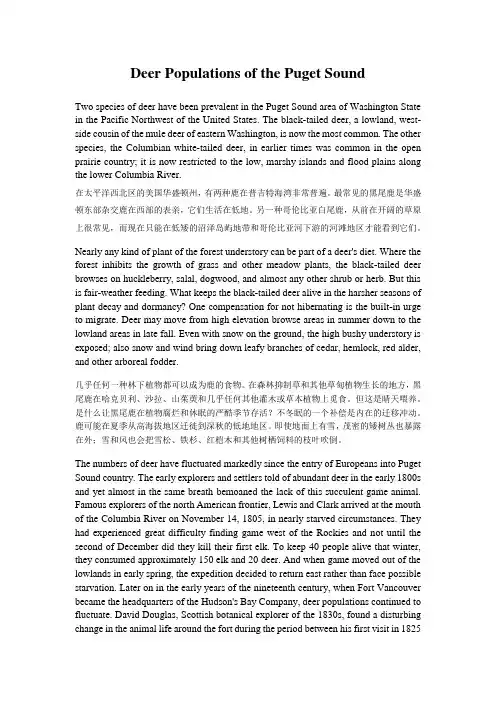
Deer Populations of the Puget SoundTwo species of deer have been prevalent in the Puget Sound area of Washington State in the Pacific Northwest of the United States. The black-tailed deer, a lowland, west-side cousin of the mule deer of eastern Washington, is now the most common. The other species, the Columbian white-tailed deer, in earlier times was common in the open prairie country; it is now restricted to the low, marshy islands and flood plains along the lower Columbia River.在太平洋西北区的美国华盛顿州,有两种鹿在普吉特海湾非常普遍。
最常见的黑尾鹿是华盛顿东部杂交鹿在西部的表亲,它们生活在低地。
另一种哥伦比亚白尾鹿,从前在开阔的草原上很常见,而现在只能在低矮的沼泽岛屿地带和哥伦比亚河下游的河滩地区才能看到它们。
Nearly any kind of plant of the forest understory can be part of a deer's diet. Where the forest inhibits the growth of grass and other meadow plants, the black-tailed deer browses on huckleberry, salal, dogwood, and almost any other shrub or herb. But this is fair-weather feeding. What keeps the black-tailed deer alive in the harsher seasons of plant decay and dormancy? One compensation for not hibernating is the built-in urge to migrate. Deer may move from high elevation browse areas in summer down to the lowland areas in late fall. Even with snow on the ground, the high bushy understory is exposed; also snow and wind bring down leafy branches of cedar, hemlock, red alder, and other arboreal fodder.几乎任何一种林下植物都可以成为鹿的食物。
托福阅读TPO真题全文本答案译文
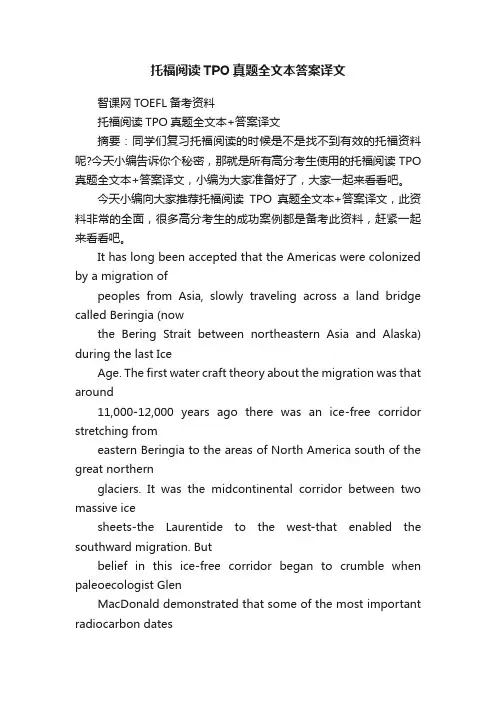
托福阅读TPO真题全文本答案译文智课网TOEFL备考资料托福阅读TPO真题全文本+答案译文摘要:同学们复习托福阅读的时候是不是找不到有效的托福资料呢?今天小编告诉你个秘密,那就是所有高分考生使用的托福阅读TPO 真题全文本+答案译文,小编为大家准备好了,大家一起来看看吧。
今天小编向大家推荐托福阅读TPO真题全文本+答案译文,此资料非常的全面,很多高分考生的成功案例都是备考此资料,赶紧一起来看看吧。
It has long been accepted that the Americas were colonized by a migration ofpeoples from Asia, slowly traveling across a land bridge called Beringia (nowthe Bering Strait between northeastern Asia and Alaska) during the last IceAge. The first water craft theory about the migration was that around11,000-12,000 years ago there was an ice-free corridor stretching fromeastern Beringia to the areas of North America south of the great northernglaciers. It was the midcontinental corridor between two massive icesheets-the Laurentide to the west-that enabled the southward migration. Butbelief in this ice-free corridor began to crumble when paleoecologist GlenMacDonald demonstrated that some of the most important radiocarbon datesused to support the existence of an ice-free corridor were incorrect. Hepersuasively argued that such an ice-free corridor did not exist until much later,when the continental ice began its final retreat.Support is growing for the alternative theory that people using watercraft,possibly skin boats, moved southward from Beringia along the Gulf of Alaskaand then southward along the Northwest Coast of North America possibly asearly as 16,000 years ago. This route would have enabled humans to entersouthern areas of the Americans prior to the melting of the continental glaciers.Until the early 1970s, most archaeologists did not consider the coast apossible migration route into the Americans because geologists originallybelieved that during the last Ice Age the entire Northwest Coast was coveredby glacial ice. It had been assumed that the ice extended westward from theAlaskan/Canadian mountains to the very edge of the continental shelf, the flat,submerged part of the continent that extend into the ocean. This would havecreated a barrier of ice extending from the Alaska Peninsula, through the Gulfof Alaska and southward along the Northwest Coast of NorthAmerica to whatis today the state of Washington.1The most influential proponent of the coastal migration route has beenCanadian archaeologist Knut Fladmark. He theorized that with the use ofwatercraft, people gradually colonized unglaciated refuges and areas alongthe continental shelf exposed by the lower sea level. Fladmark's hypothesisreceived additional support from the fact that the greatest diversity in NativeAmerican languages occurs along the west coast of the Americans,suggesting that this region has been settled the longest.以上就是小编向大家推荐的托福阅读TPO真题全文本+答案译文的部分精彩内容,各位考生可以点击下载按钮进行免费的资料索取,希望小编的资料能帮助到大家。
TPO阅读44文本答案翻译
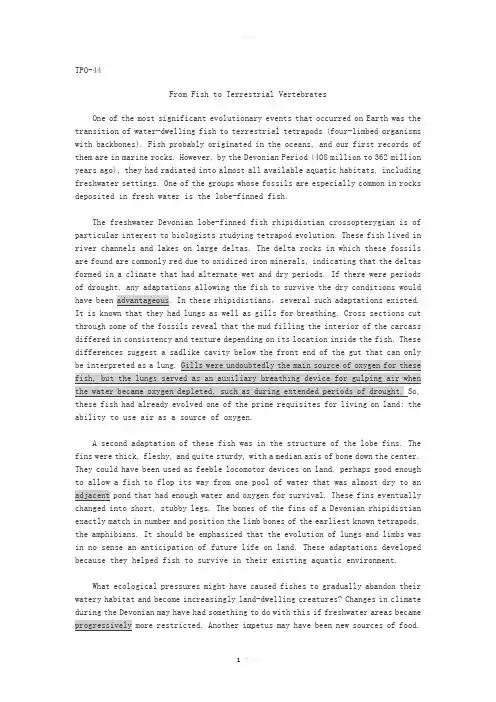
TPO-44From Fish to Terrestrial VertebratesOne of the most significant evolutionary events that occurred on Earth was the transition of water-dwelling fish to terrestrial tetrapods (four-limbed organisms with backbones). Fish probably originated in the oceans, and our first records of them are in marine rocks. However, by the Devonian Period (408 million to 362 million years ago), they had radiated into almost all available aquatic habitats, including freshwater settings. One of the groups whose fossils are especially common in rocks deposited in fresh water is the lobe-finned fish.The freshwater Devonian lobe-finned fish rhipidistian crossopterygian is of particular interest to biologists studying tetrapod evolution. These fish lived in river channels and lakes on large deltas. The delta rocks in which these fossils are found are commonly red due to oxidized iron minerals, indicating that the deltas formed in a climate that had alternate wet and dry periods. If there were periods of drought, any adaptations allowing the fish to survive the dry conditions wouldIn these rhipidistians,several such adaptations existed. It is known that they had lungs as well as gills for breathing. Cross sections cut through some of the fossils reveal that the mud filling the interior of the carcass differed in consistency and texture depending on its location inside the fish. These differences suggest a sadlike cavity below the front end of the gut that can onlythese fish had already evolved one of the prime requisites for living on land: the ability to use air as a source of oxygen.A second adaptation of these fish was in the structure of the lobe fins. The fins were thick, fleshy, and quite sturdy, with a median axis of bone down the center. They could have been used as feeble locomotor devices on land, perhaps good enough to allow a fish to flop its way from one pool of water that was almost dry to anpond that had enough water and oxygen for survival. These fins eventually changed into short, stubby legs. The bones of the fins of a Devonian rhipidistian exactly match in number and position the limb bones of the earliest known tetrapods, the amphibians. It should be emphasized that the evolution of lungs and limbs was in no sense an anticipation of future life on land. These adaptations developed because they helped fish to survive in their existing aquatic environment.What ecological pressures might have caused fishes to gradually abandon their watery habitat and become increasingly land-dwelling creatures? Changes in climate during the Devonian may have had something to do with this if freshwater areas becameThe edges of ponds and streams surely had scattered dead fish and other water-dwelling creatures. ■In addition, plants had emerged into terrestrial habitats in areas near streams and ponds, and crabs and other arthropods were also members of this earliest terrestrial community. ■Thus, by the Devonian the land habitat marginal to freshwater was probably a rich source of protein that could be exploited by an animal that could easily climb out of water. ■Evidence from teeth suggests that these earliest tetrapods did not utilize land plants as food; they were presumably carnivorous and had not developed the ability to feed on plants. ■How did the first tetrapods make the transition to a terrestrial habitat? Like early land plants such as rhyniophytes, they made only a partial transition; they were still quite tied to water. However, many problems that faced early land plants were not applicable to the first tetrapods. The ancestors of these animals already had a circulation system, and they were mobile, so that they could move to water to drink. Furthermore, they already had lungs, which rhipidistians presumably used for auxiliary breathing. The principal changes for the earliest tetrapods were in the skeletal system—changes in the bones of the fins, the vertebral column, pelvic girdle, and pectoral girdle.P1:One of the most significant evolutionary events that occurred on Earth was the transition of water-dwelling fish to terrestrial tetrapods (four-limbed organisms with backbones). Fish probably originated in the oceans, and our first records of them are in marine rocks. However, by the Devonian Period (408 million to 362 million years ago), they had radiated into almost all available aquatic habitats, including freshwater settings. One of the groups whose fossils are especially common in rocks deposited in fresh water is the lobe-finned fish.1. Paragraph 1 supports which of the following statements about fish evolution?A. Lobe-finned fish were among the earliest types of fish to appear.B. Fish began living in freshwater habitats only after originating elsewhere.C. Lobe-finned fish radiated into almost all available aquatic habitats.D. During the Devonian, lobe-finned fish were more common in marine than in freshwater habitats.P2:The freshwater Devonian lobe-finned fish rhipidistian crossopterygian is of particular interest to biologists studying tetrapod evolution. These fish lived in river channels and lakes on large deltas. The delta rocks in which these fossils are found are commonly red due to oxidized iron minerals, indicating that the deltas formed in a climate that had alternate wet and dry periods. If there were periods of drought, any adaptations allowing the fish to survive the dry conditions wouldIn these rhipidistians,several such adaptations existed. It is known that they had lungs as well as gills for breathing. Cross sections cut through some of the fossils reveal that the mud filling the interior of the carcassdiffered in consistency and texture depending on its location inside the fish. These differences suggest a sadlike cavity below the front end of the gut that can onlythese fish had already evolved one of the prime requisites for living on land: the ability to use air as a source of oxygen.2. According to paragraph 2, what do the minerals in the delta rocks containing rhipidistian crossopterygian fossils reveal?A. These deltas formed in dry periods but gradually became wetter.B.These deltas contain different types of iron minerals than do the surrounding areas.C.Most rhipidistian crossopterygian fish died when the climate became dry.D.Rhipidistian crossopterygian fish lived in areas that experienced alternate dry and wet periods.A. beneficialB. necessaryC. remarkableD. common4. In paragraph 2, why does the author include the information that mud inside rhipidistian crossopterygian fossils differed in consistency and texture depending on where the mud was located?A. To provide evidence that rhipidistian crossopterygian lived in river channels and lakes on large deltas.B. To identify an effect of the oxidation of iron minerals on the evolution of rhipidistian crossopterygian.C. To help explain why scientists have concluded that rhipidistian crossopterygian probably had lungs.D. To explain why scientists decided to cut cross sections through some fossils of rhipidistian crossopterygian.5. Which of the sentences below best expresses the essential information in the highlighted sentence in the passage? Incorrect choices change the meaning in important ways or leave out essential information.A. Because the lungs of these fish were able to provide only a small amount of oxygen, these fish obtained most of their oxygen through their gills during periods of drought.B. During periods of extended drought, these fish used their lungs to increase their intake of oxygen beyond the levels absorbed by the gills in normal times.C. Although these fish primarily used their gills to obtain oxygen, they used their lungs to obtain oxygen from the air when there was not enough in the water.D. During periods of extended drought, the gills became an auxiliary breathing device and the lungs became the main source of oxygen for these fish.6. Which of the sentences below best expresses the essential information in the highlighted sentence in the passage? Incorrect choices change the meaning in important ways or leave out essential information.A. Because the lungs of these fish were able to provide only a small amount of oxygen, these fish obtained most of their oxygen through their gills during periods of drought.B. During periods of extended drought, these fish used their lungs to increase their intake of oxygen beyond the levels absorbed by the gills in normal times.C. Although these fish primarily used their gills to obtain oxygen, they used their lungs to obtain oxygen from the air when there was not enough in the water.D. During periods of extended drought, the gills became an auxiliary breathing device and the lungs became the main source of oxygen for these fish.P3:A second adaptation of these fish was in the structure of the lobe fins. The fins were thick, fleshy, and quite sturdy, with a median axis of bone down the center. They could have been used as feeble locomotor devices on land, perhaps good enough to allow a fish to flop its way from one pool of water that was almost dry to anpond that had enough water and oxygen for survival. These fins eventually changed into short, stubby legs. The bones of the fins of a Devonian rhipidistian exactly match in number and position the limb bones of the earliest known tetrapods, the amphibians. It should be emphasized that the evolution of lungs and limbs was in no sense an anticipation of future life on land. These adaptations developed because they helped fish to survive in their existing aquatic environment.Too many words you don’t know? Look them up in《新托福TPO阅读词汇速查速记》! Wechat: geeqi0805A. nearbyB. availableC. temporaryD. freshYou enjoy the convenience of having all vocabulary questions listed as a separate part in《新托福TPO阅读词汇速查速记》.P4:What ecological pressures might have caused fishes to gradually abandon their watery habitat and become increasingly land-dwelling creatures? Changes in climate during the Devonian may have had something to do with this if freshwater areas becameThe edges of ponds and streams surely had scattered dead fish and otherwater-dwelling creatures. ■In addition, plants had emerged into terrestrial habitats in areas near streams and ponds, and crabs and other arthropods were also members of this earliest terrestrial community. ■Thus, by the Devonian the land habitat marginal to freshwater was probably a rich source of protein that could be exploited by an animal that could easily climb out of water. ■Evidence from teeth suggests that these earliest tetrapods did not utilize land plants as food; they were presumably carnivorous and had not developed the ability to feed on plants. ■8. The word in the passage is closest in meaning to:A. increasinglyB. noticeablyC. occasionallyD. rapidly9. In paragraph 4, why does the author point out that crabs and other arthropods were already living on land when the ancestors of the first tetrapods began living there?A. To account for the presence of dead fish along the edges of ponds and streams during the Devonian.B. To support the claim that climate change caused freshwater habitats to become more restricted during the Devonian.C. To identify a consequence of the emergence of plants into terrestrial habitats near ponds and streams.D. To identify a possible reason for why certain fish gradually became terrestrial organisms.10. According to paragraph 4,teeth of the earliest tetrapods suggest that these tetrapodsA. competed with other animals for proteinB. were probably carnivoresC. could easily climb out of waterD. were able to eat plantsP5:How did the first tetrapods make the transition to a terrestrial habitat? Like early land plants such as rhyniophytes, they made only a partial transition; they were still quite tied to water. However, many problems that faced early land plants were not applicable to the first tetrapods. The ancestors of these animals already had a circulation system, and they were mobile, so that they could move to water to drink. Furthermore, they already had lungs, which rhipidistians presumably used for auxiliary breathing. The principal changes for the earliest tetrapods were in the skeletal system—changes in the bones of the fins, the vertebral column, pelvic girdle, and pectoral girdle.11. According to paragraph 5, which of the following was true of the first tetrapods?A. They became dependent for food on organisms already living on land.B. They needed to develop new mechanisms for obtaining nutrients.C. They continued to live in close association with aquatic environments.D. They were evolutionarily far removed from their rhipidistian ancestors.12. According to paragraph 5, what was the main way that the earliest tetrapods differed from their immediate fish ancestors?A. The tetrapods had a different skeletal structure.B. The tetrapods had more sources of food availableC. The tetrapods had a circulation system.D. The tetrapods could move to new pools of water.P4:What ecological pressures might have caused fishes to gradually abandon their watery habitat and become increasingly land-dwelling creatures? Changes in climate during the Devonian may have had something to do with this if freshwater areas becameThe edges of ponds and streams surely had scattered dead fish and other water-dwelling creatures. ■In addition, plants had emerged into terrestrial habitats in areas near streams and ponds, and crabs and other arthropods were also members of this earliest terrestrial community. ■Thus, by the Devonian the land habitat marginal to freshwater was probably a rich source of protein that could be exploited by an animal that could easily climb out of water. ■Evidence from teeth suggests that these earliest tetrapods did not utilize land plants as food; they were presumably carnivorous and had not developed the ability to feed on plants. ■13. Look at the four squares [■] that indicate where the following sentence could be added to the passage.These would have been deposited by the receding waters of droughts, during which many aquatic animals must have died.Where would the sentence best fit? Click on a square [■] to add the sentence to the passage14. Directions: An introductory sentence for a brief summary of the passage is provided below. Complete the summary by selecting the THREE answer choices that express the most important ideas in the passage. Some sentences do not belong in the summary because they express ideas that are not presented in the passage or are minor ideas in the passage. This question is worth 2 points.Freshwater lobe-finned fish may be the direct ancestors of terrestrial tetrapods.●●●Answer ChoicesA. Rhipidistian crossopterygian had features such as primitive lungs and thick fins that could have helped it survive dry periods.B. During the Devonian, the number of bones increased in the fins of rtiipidistians, improving such animals’ ability to swim and move over landC. Shortly after the earliest tetrapods developed lungs, plants and other animals began to flourish on land.D. By the Devonian period, lobe-finned fish preferred freshwater habitats to life in the ocean.E. A drier climate and new sources of food on land may have encouraged the lobe-finned fish’s move to a terrestrial existence.F. Early tetrapods remained closely connected to water, but several of their body structures were adapted for life on land.参考答案:1-5.BDACC 6-10.DAADB 11-13.CAA 14.AEFIf you have any questions concerning the texts or answers, feel free to contact Wechat: geeqi0805.If you are tired of looking up TPO words in a dictionary, try《新托福TPO阅读词汇速查速记》!参考译文:从鱼类到陆生脊椎动物水中栖息的鱼类进化为陆地四足动物(有脊椎的四肢生物)是地球上发生过的重大进化事件之一。
TPO-30 Reading 1 阅读译文
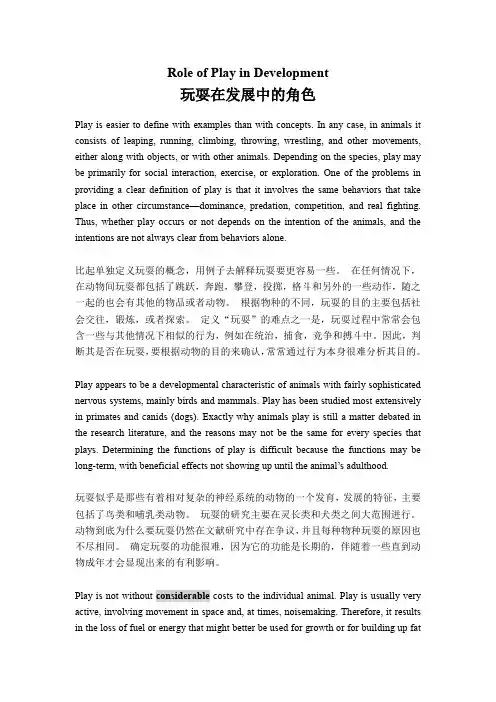
Role of Play in Development玩耍在发展中的角色Play is easier to define with examples than with concepts. In any case, in animals it consists of leaping, running, climbing, throwing, wrestling, and other movements, either along with objects, or with other animals. Depending on the species, play may be primarily for social interaction, exercise, or exploration. One of the problems in providing a clear definition of play is that it involves the same behaviors that take place in other circumstance—dominance, predation, competition, and real fighting. Thus, whether play occurs or not depends on the intention of the animals, and the intentions are not always clear from behaviors alone.比起单独定义玩耍的概念,用例子去解释玩耍要更容易一些。
在任何情况下,在动物间玩耍都包括了跳跃,奔跑,攀登,投掷,格斗和另外的一些动作,随之一起的也会有其他的物品或者动物。
根据物种的不同,玩耍的目的主要包括社会交往,锻炼,或者探索。
定义“玩耍”的难点之一是,玩耍过程中常常会包含一些与其他情况下相似的行为,例如在统治,捕食,竞争和搏斗中。
托福TPO阅读真题及译文:Spartina
托福TPO阅读真题及译文:Spartina新通外语广州学校小编整理了一篇托福TPO阅读真题里的一篇文章(Spartina),并附上中文翻译,正在备考托福阅读的考生们,建议多积累托福阅读背景资料,适当地运用托福TPO。
托福TPO阅读真题:Spartina第一段:托福TPO阅读原文:Spartina alterniflora, known as cordgrass, is a deciduous, perennial flowering plant native to the Atlantic coast and the Gulf Coast of the United States. It is the dominant native species of the lower salt marshes along these coasts, where it grows in the intertidal zone (the area covered by water some parts of the day and exposed others).托福TPO阅读翻译:互花米草,俗称网茅,是一种落叶的多年生开花植物,原产自美国大西洋沿岸和墨西哥湾地区。
它是这些海岸下游地区盐碱地的优势本地种,生长在潮间带(有时淹没在水中,有时暴露在空气中的区域)。
第二段:托福TPO阅读原文:These natural salt marshes are among the most productive habitats in the marine environment. Nutrient-rich water is brought to the wetlands during each high tide, making a high rate of food production possible. As the seaweed and marsh grass leaves die, bacteria break down the plant material, and insects, small shrimplike organisms, fiddler crabs, and marsh snails eat the decaying plant tissue, digest it, and excrete wastes high in nutrients. Numerous insects occupy the marsh, feeding on living or dead cordgrass tissue, and redwing blackbirds, sparrows, rodents, rabbits, and deer feed directly on the cordgrass. Each tidal cycle carries plant material into the offshore water to be used by the subtidal organisms.托福TPO阅读翻译:这些天然的盐碱地位于海洋环境下最肥沃的生境中。
TPO-40 Reading 1 翻译
参考译文古雅典在公元前800年到公元前500年之间,希腊的一个的最重要的变化就是城邦(也叫做city-state)的兴起,每个城邦会发展出一个适合自己情况的政府系统。
雅典所遇到并被解决的问题包括:已经存在的贵族和逐渐出现的其他阶级之间对于政治权利的分享,将贵族的生活方式到新兴的城邦生活方式的调整。
就是所有这些元素的和谐融合产生了雅典的古典文明。
进入到了城邦时代,雅典有着其他希腊原始民主城邦的传统机构:甶男性组成的议会机构,一个贵族委员会,还有年度选举的官员。
从这个传统的架构中,在公元前600年到公元前450年间,雅典人逐渐发展出了希腊人认为完全成熟的民主宪法,尽管从现在的角度来看,拥有投票权的人还是相对较少。
第一批改革发生在公元前594年,由Solon打破了由贵族阶层推举官员这个规则的束缚,决定通过建立财富而不是靠出身作为任职的基础,废除了雅典人民对贵族的经济义务(释:底层民众有义务给贵族钱,比如上供、税收等方式),并且使得议会(议会中的所有公民都是平等的)在某些情况下能够驳回地方法庭的判决。
因为一种叫僭主政体政府的兴起,雅典贵族的力量在本世纪之后的时间里被进一步削弱。
这是一种甶受欢迎的铁腕统治者临时统治的管理形式(而非现在这个词儿所暗示出来的残暴的独裁者的统治)。
这些专治统治者们被称作庇西特拉图家族(根据王朝的建立者庇西特拉图命名),他们牺牲了贵族,在全国各区域任命法官,创造出雅典的第一个国家货币制度,同时增加并改良了一些节日,这些节日是全国性质的,而不是只针对某个地区的习俗。
这些做法加强了雅典的中央管理。
在这个世纪的最后,时机已经成熟,更多变化应运而生:僭主被驱逐,并且在公元前508年,一个新的改革家,克利斯提尼,提出了最终的发展形式,降低了本来已经被削弱的贵族的控制力。
克利斯提尼对于雅典民主制度出现的主要贡献就是完全地推翻了长期以来一直薄弱的家族和氏族结构,特别是贵族家族和氏族。
取而代之的是,设立了以地区为基础的群体,称作市区;市区这种形式成为了雅典公民生活和大部分宗教生活的起点。
TPO-40 Reading 2 翻译
参考译文纬度和生物多样性当我们观察地表生物多样性的分布情况时,我们会发现这个分布完全不平均。
热带地区整体上要比高纬度的同等区域包含更多的物种。
很多不同的动植物群中都有这个情况存在。
为什么高纬度地区的多样性要低于热带地区?可能仅仅是陆地面积的问题。
热带地区的陆地面积要比高纬度地区更大——尽管当我们一般用投影的方法测量土地曲面的时候,这个事实并不是特别明显,因为这也很容易导致高纬度地区的面积会被放大——所以科学家认为地区生物多样性的差异是这个原因导致的。
但是,生物学家Klaus Rohde的数据分析不支持这种解释理论。
虽然陆地面积可能决定生物多样性,但是这肯定不是唯一的原因;要不然,面积大的陆地总会有更多的物种。
生物的繁殖能力貌似涉及其中,尽管可能它的作用并不是直接的。
在条件特别适合植物生长的地区,换句话说,在那些温度相对高而且相对稳定的地区,并且在那些有充足水分的地区--我们通常会发现大量的植被。
这就导致植被层的结构很复杂。
比如说,在热带雨林地区,大量的植物会在地表上方积累。
同样还存在大量物质,在地下作为植物根系生长,但是这些物质不太容易被看到。
对于地表上方植物的精细分析表明这些植物分布成好几层。
具体的层数根据年龄以及森林的特质而变化。
这些植物生物量(背景知识补充:单位面积内有机物质的总量)在层中的分布,被定义成“structure〃(相反于"composition",这个词指的是形成了群落的生物物种)。
structure本质上就是植被的层次结构,并且就像在热带丛林中一样,它会非常复杂。
在亚马逊河流盆地的一片成熟的冲击平原热带丛林中,树冠层(森林中的最上层,甶树冠组成)是多层结构。
在叶片覆盖中存在三个清晰的顶部,分别在地面上方大约3米、6米和30米的高度;最高的一层,50米的那层,生长的是非常高的那些树,这些树脱离于主树冠层而生长,并且它们单独能够形成开阔的一层。
所以,这样的森林基本上包含四层树冠层。
TPO-40 Reading 3 翻译
参考译文两栖动物的温度调节不同于晡乳动物和鸟类,两栖动物不能通过代谢活动产生热能,没有这些热能,他们就必须依赖周围环境的温度而控制体温。
然而,两栖动物不能以任何方式控制体温的观点被证明是错误的,因为它们的体温并不总是随着周围环境温度变化。
虽然两栖动物不是高级的体温控制者,但它们确实会通过控制体温而把体温限制在一定程度内。
生理适应能力能帮助两栖动物在极端条件的栖息地中生存。
体温的忍耐范围代表着生物能够生存的环境温度范围。
一种北美蝾螈在温度降到零下2摄氏度的时候仍旧能够活动,而一种南美青蛙即使温度上升到41摄氏度的时候仍旧感觉舒适——这个温度是自然放养的两栖类动物中测量到的最高体温。
最近被发现的是,北美青蛙和蟾蜍在零下6摄氏度的体温下能够活到五天之久,哪怕它们几乎三分之一的体液都冻住了。
身体的其他的组织被保护着,因为它们含有防冻剂甘油或葡萄糖。
此外,在很多物种中,忍耐范围很灵活,在适应环境(长期暴露在某种特定条件中)之后,忍耐范围会变化。
尽管白天温度很高,一些青蛙仍旧暴露在太阳之下。
这些青蛙在表皮结构方面表现出一些显著的变化,属于形态上的适应能力。
大部分两栖动物的皮肤是透水性的,所以不能抵抗水分蒸发或太阳辐射。
非洲草原蛙Hyperolius viridiflavus将鸟嘌昤晶体储存在皮肤中,使得皮肤更好的反射太阳辐射,从而不会温度过高。
树蛙Phyllomedusa sauvagei依靠腺体分泌物而抵抗蒸发损失的水分,这些分泌物在树蛙全身形成一层油膜,防止水分丢失。
然而,目前为止,行为是最重要的体温调节方式。
体温调节的主要行为方式是:晒太阳(heliothermy),与基质(如石头或土)的热交换 (thigmothermy),以及白天的躲避行为和每年的回避行为(比如白天躲在阴凉处,以及冬眠和夏眠,分别指的是在寒冷或酷热天气中减少活动)。
Heliotherm在青蛙和蟾蜍中特别普遍:这种方法使得它们的体温上升十多度。
- 1、下载文档前请自行甄别文档内容的完整性,平台不提供额外的编辑、内容补充、找答案等附加服务。
- 2、"仅部分预览"的文档,不可在线预览部分如存在完整性等问题,可反馈申请退款(可完整预览的文档不适用该条件!)。
- 3、如文档侵犯您的权益,请联系客服反馈,我们会尽快为您处理(人工客服工作时间:9:00-18:30)。
TPO 11.1【阅读第一篇】:《山上树带界线的植被》在山坡上,从森林到没树的苔原间的过渡通常是很剧烈的,引人注目的。
仅仅在几十米的垂直距离中,树木这种生命形式就消失了,取而代之的是低矮的灌木植物、草本植物和牧草。
这种迅速过渡的区域被称作为上行树带界线或林木线。
在很多半干旱的地区,存在着下行树带界线,在下行树带界线里,森林延伸到干草原或是较低的沙漠,而这种过渡通常是因为缺少水分而导致的好比像万年雪线那样,上行树带界线出现在热带最高区域或在极地最低区域。
从极地地区的海平面到干燥亚热带的海拔4500米处以及潮湿热带地区的3500—4500米处都遍布了上行树带界线。
树带界线中的树木通常是常青树,而四季常青表现出了它们胜于每年落叶树的优势。
然而,在一些地区,树带界线是由落叶阔叶林的树木所组成。
例如,在喜马拉雅的部分地区,桦树的一些物种就在树带界线里。
在上行树带界线上,树木开始扭曲变形。
尤其在中高纬度地区的树木,这些地区的树木往往会在山脊上达到更高,而在热带地区的树木则在山谷里长得更高。
这是因为中高纬度地区树带界线受积雪覆盖时间和深度的影响因素较大。
由于在山谷中,积雪覆盖较厚且持续时间很长,所以树木往往在山脊上长得更高,就算它们会暴露在大风或生长在贫瘠的土地中。
在热带地区的山谷中更有利于生长,因为山谷不太可能干掉的,也少有霜冻,且有更深的土壤。
目前还没有一个完全统一的解释来说明为什么在树带界线上,会出现树木突然停止生长的情况。
可能是由于各种环境因素的影响,比如,过多的积雪让树木窒息,雪崩和雪移伤害或破坏了树木;长时间的积雪将有效的生长季节时间缩短到种子都不够发芽的;另外,风速会随着高度的上升而增加,并且给树木带来更大的压力,在高海拔地区树木的变形就是证据。
一些科学家提出,随着高度的上升而不断增强的紫外线是影响因素之一,而野生山羊等动物的放养是另一个影响因素,这些都是导致树木突然停止生长的因素。
或许最重要的环境因素是温度,因为如果生长季节太短并且温度太低,那么树芽和树苗都无法充分成熟来度过冬季。
在林木线上有一个区域称作高山苔原地区。
■由于紧挨着树带界线,苔原上都是矮灌木、药材和草地。
随着海拔的增加物种的数量和多样性会逐渐减少,直到出现大量带有些许苔藓的贫瘠之地和地衣这样的伏地植物。
■有些植物甚至可以在雪线以上有利的小环境中生存,世界上海拔最高的植物是出现在喜马拉雅山上6100米的马卡鲁峰。
■在这个高度上,被阳光加热过的岩石可以将小型雪堆融化。
■高山植物最突出的特点是其低矮的生长形态。
这种特点使他们能够抵御最恶劣的强风环境,并且有助于它们利用来自地表的高温。
在这样一个不适宜生命的低温地区,地表提供的额外温度很重要。
低矮的生长形态也可以帮助植物充分利用冬季积雪所提供的保温环境。
在赤道区的山脉上低矮的生长形态就很少见了。
1.2 【阅读第二篇】:《戏剧的起源》由于几乎没有具体的证据供我们下结论,探寻戏剧的起源只能主要凭推测。
19世纪末20世纪初人类学家们所拥护的一种理论得到了世人的广泛认同;这种观点认为戏剧起源于神话和宗教仪式,这些人类学家们推论过程可简要概括如下:在社会发展早期,人们觉得有股力量可以影响甚至操控他们的食物供应和幸福生活。
在对自然原因并不十分了解的情况下,他们把希望或不希望发生的事情都归咎于超自然的或魔幻的力量,并且试图寻找各种途径赢得这些力量的厚爱。
当他们意识到自己的某些行为和期许的结果之间存在明显的联系以后,人们便开始重复并且完善这些行为,最终形成正式的典礼或宗教仪式。
故事(神话)在这种宗教仪式中发展起来,这些神话中通常包括以超自然力量为代表的庆祝或期望带来影响的仪式。
在这种仪式或伴随的庆典中,表演者们会穿上戏装,戴上面具来扮演神秘的角色或超自然力量。
当人们认识事物的能力进一步加强的时候,他们对超自然力量以及与其引发的事件间因果关系的认识就发生了改变;于是,他们会抛弃或者修改某些仪式。
不过在这些仪式中发展起来的神话故事继续在人们的口头流传,甚至可能脱离了仪式而被演绎着。
这时侯,戏剧做为一种自发的活动迈出了自己的第一步,接着,戏剧的娱乐和审美价值开始渐渐取代先前的带有神话色彩的、在社会上灵验的关注。
尽管戏剧起源于宗教仪式的说法最被大众认可,但这并不是戏剧起源的唯一理论;另一种推测认为戏剧源于说书。
在这个推测的理论中,与故事产生联系和聆听故事被视为是人类基本的乐趣。
因此,讲述人通过自己的手势和模仿把对一个事件的回忆(一次打猎、战役或是其它功勋伟业)表现的淋漓尽致,这种方式最终演变成为由不同的人来演绎不同的角色。
另外一种与之相关的理论视戏剧由无声的、有节奏的舞蹈、体操,或模仿动物声音的过程逐渐演变而来。
人们对表演者的演技、精湛技巧和优雅的欣赏被视为是表演者将他们的表演精心策划为戏剧的动力。
为了进一步探索戏剧的起源,一些学派同时从人类发展戏剧的动机上建立理论。
为什么戏剧会发展,为什么在戏剧在中断宗教仪式以后还有这么大的价值?大部分答案都回到那些关于人类心智和人类基本需求的理论中首先亚里士多德在公元前4世纪提出,他认为人们天生好模仿,并从模仿他人、事物和动作以及观看模仿中获得乐趣。
其次,20世纪提出的先进理论认为人类擅长幻想,并且通过幻想将现实重塑成比日常生活中遇到的事情更加令人满意的形式。
因此,幻想或虚构(戏剧的一个形式)让人们他们的焦虑和恐惧具体化,面对焦虑和恐惧,并从虚构中满足他们现实中无法实现的愿望。
所以,戏剧成为了一种帮助人们认识和理解这个世界,或是说帮助人们逃避不满现实的工具。
但是,无论是人类模仿的本能或是对幻想的本身都不能发展成为独立的戏剧,因此,我们需要更多解释。
一个必要的条件看上去是要人们脱离平时看问题的视角。
比如,这个必要条件的标志之一是喜剧构想的出现,因为喜剧要求足够的发散思维,我们需要将社会规范中的有偏差的行为视作荒谬的事情,而不是对人们幸福生活的严重威胁。
另一个导致戏剧独立的条件是审美的出现。
例如,一些早期社会的人们不再认为那些仪式对他们的幸福生活来说是必需品,并且取消了那些仪式。
虽然如此,人们还是保留了那些口头传述故事的传统并且热爱从这些仪式里发展起来的神话,出于它们的艺术性,而不是宗教原因。
1.3 【阅读第三篇】:《地下水》地下水是指渗入到地下的水,它将所有岩石空隙填满。
到现在为止,最丰富的地下水是雨水,它是地下水在水循环中的一个环节。
普通的雨水会从地表、降水以及湖泊河流侵入到地下。
在冒出地表之前,这些地下水有时会长时间留在地下。
这在一开始会让人觉得难以置信,在我们脚下坚实的土地中竟然有足够的空间储存这些水。
地下水所需的储存空间多种多样。
最常见的储存地下水的空间是松散的砂子和砾石间的颗粒和卵石之间的空隙。
由这些颗粒组成的水床非常普遍,通常位于看不见的土壤下方。
在湍急的河流曾经流过的地方都能找到它们的踪迹。
比如,冰河时代覆盖北美的巨大冰层逐渐融化,大量水从那儿流出。
水里充满了石子、砾石和沙石,被称为冰水沉积,这些颗粒会随着水流的减速而沉淀。
现代也有冰水沉积,尽管规模相对较小。
凡是有多泥沙的河流或者溪流从山谷流至相对平坦的地面时,泥沙量会随着水流速度的减慢逐渐减少。
水流通常呈扇形扩散,它们所携带的砂石也会沉淀为光滑的扇形斜面。
当河流减慢汇入湖泊和海洋的时候也会有沉淀,这些沉淀最初在湖底或海底,但当海平面下降或者陆地崛起时,它们就会分布于内陆,这样的沙床通常厚达几千米。
低地区域上的几乎任何位置可能被土壤覆盖的曾经的河床。
如果那些河床和沙洲现在位于地下水位之下,沙砾和砂石就会被地下水所填满。
以上说的都是松散的沉积物。
那些坚固的(或胶结沉积物)沉积物,也拥有以数万计的毛细孔来容纳水。
因为最初颗粒间的缝隙通常并未完全被粘固的化学物质塞满,而且部分最初的颗粒很可能在固化时或固化后的任何时间被渗入的地下水溶解;结果是这些砂岩最终变得和形成它的散沙一样多孔。
因此,不管沉积物是疏松还是坚固,他们中一定有一部分空着的空间。
大部分结晶体岩石都非常坚硬,但也有例外,最常见的就是玄武岩,它是一种固化的火山熔岩,经常充满了微小气泡,从而变得十分多孔。
岩石空隙部分所占的比例被称作岩石的多孔性。
但需要注意的是,多孔性与渗透性是不同的。
渗透性是衡量水渗透物质的难易程度,它取决于与单个空隙以及连接空隙间裂缝的大小。
当充满水分的沉淀物或者岩石样本被放置在适合的干燥环境中时,大部分的水分会流干。
但仍有部分水会继续附着在坚实的表面上。
它们被表面张力保留在那里,如果没有表面张力,水分会立刻蒸发。
因此,试验样本的含水量既包括可以流干的水,也包括不能流干的水。
这两种水的相对含量因岩石或沉积物种类不同而改变,即便它们的空隙一样大。
另外还取决于空隙的大小。
如果空隙很大,其中的水会形成水滴,太重足以克服吸引它的表面张力,就会流走;但如果空隙够小,水会像薄膜一样,太轻无法克服表面张力,从而坚固地附着在空隙表面上。
TPO 21.1【阅读第一篇】:《沙漠的形成》沙漠已经占据地球表面积约四分之一,但最近几十年正以惊人的速度扩张。
沙漠漫延到非沙漠区域叫做沙漠化。
预计地球表面另外四分之一的土地正面临沙漠化威胁。
导致沙漠化的原因主要是:随着自然植被的不断减少,风力和雨水加速了土壤的腐蚀。
有的时候松散的土壤全部被风刮走,留下石质化的表层。
而有的时候细小的沙粒可能会被吹走,而正常沙粒大小的砂子不断堆积,从而形成移动的沙丘或者沙脊。
即便是土壤表层保持完好的区域,植被的减少会导致土壤吸收地下水的能力下降,雨水对松散土壤的冲击会把细小的粘土颗粒冲到土壤空隙中,从而堵塞了土壤并降低了土地表层水的渗透率。
因此土壤的吸水率大大下降,导致大量水资源流失,土壤的腐蚀率也随即增加。
植被减少,地表吸收水分的能力逐渐减弱使得土壤越发干燥,于是导致了土壤沙漠化的恶性循环。
在一些地区,沙漠面积的增加很大程度上归因于干燥的气候。
在过去的几千年里,全球温度不断上升使得一些地方干旱问题愈发严重。
倘若空气污染导致的全球变暖越来越严重,沙漠化进程会在未来数十年内加速。
然而,毋庸置疑的是,大部分地区沙漠化主要都是由于人类活动导致,而非自然条件所致。
沙漠边缘的半干旱土地所处的生态环境十分脆弱,环境的压力在持续增加,而这些半干旱区域适应环境压力的能力极其有限。
人口数量的增加使得人们不断向土地施压来提供实物和燃料。
在湿润的季节里,土地也许能够应付这些压力。
但是在干旱的季节里,在沙漠周边的土地上,存在着这样一个十分普遍的现象:人类对土地施加的压力远远超过了土地自身减压的能力,因此最终导致了沙漠化。
导致沙漠化进程的主要因素有四个:过度种植,过度放牧,过分砍伐,过度灌溉。
随着人口密度的增加,人们对粮食作物的种植已经扩展到日益干燥的区域。
